Glued endocapsular hemi-ring segment enables sutureless transscleral fixation of the capsular bag
The technique aims to simplify the challenge of surgically correcting subluxated cataracts.
In the normal eye, circumferential zonular support of the capsular bag provides optimal centration of the crystalline lens. When such an eye is made pseudophakic, the IOL is also well centered, providing an optimal visual outcome following cataract surgery.
Any significant traumatic or iatrogenic loss of the zonular support of the capsular bag can compromise the final IOL position and cause unwanted visual symptoms that may require additional surgery. Traditionally, such capsular subluxations have been surgically corrected using a capsular tension ring and/or sutures that are transsclerally fixated to provide capsular stabilization and centration. Smaller, focal zonular loss usually of less than 3 clock hours may be sufficiently corrected with a capsular tension ring, while larger, circumferential zonular loss not correctable by capsular tension ring alone requires the addition of 10-0 Prolene sutures or, for suture longevity, 9-0 Prolene or 8-0 Gore-Tex sutures.
Such capsular stabilization techniques require an expanded surgical skill set and additional surgical time. Hence, anterior segment surgeons are looking for simpler surgical techniques that can help correct these more complex and surgically demanding cases.
In this column, Drs. Jacob and Agarwal describe their surgical technique of using a glued endocapsular hemi-ring segment for transscleral fixation of the capsular bag without the use of sutures.
Thomas John, MD
OSN Surgical Maneuvers Editor

Amar Agarwal

Soosan Jacob
The glued endocapsular hemi-ring segment (Epsilon Eye Instruments), designed by Dr. Jacob, aims at fulfilling the need for sutureless transscleral fixation of the capsular bag and its contents. It is manufactured using polyvinylidene fluoride, the material used for IOL haptics. This material is known to be biocompatible and inert within the eye, is flexible, has a better memory and shape-recovering capability than other IOL haptic materials, especially Prolene, and is therefore an ideal material for the intended use. It has also been found to be inert and stable within the scleral wall, because a similar scleral tuck technique has been used for the glued IOL technique and the Scharioth technique for transscleral fixation of a secondary IOL in the absence of a capsular bag.
The endocapsular hemi-ring (ECHR) segment with an open segment design is manufactured in the same gauge as IOL haptics. The two arms of the device lie within the capsular fornix. The double scroll Malyugin-type locking mechanism engages the capsulorrhexis rim atraumatically, and the haptic of the device anchors the entire capsular bag transsclerally. The device can be inserted haptic first before fish-tailing the rest of the device into the eye or by inserting the arms under the capsulorrhexis followed by the haptic. It is manufactured in different sizes, so it can extend 180° around the capsular bag or be smaller in size, depending on surgeon preference. The double scrolls and the haptic provide vertical and horizontal support to the bag during and after surgery, whereas the arms provide equatorial fornix expansion.
Surgical technique
The surgeon constructs a lamellar scleral flap in the area of the dialysis. The capsulorrhexis is then constructed followed by a gentle hydrodissection. A sclerotomy is created under the scleral flap, as would be done for a glued IOL, and a Scharioth intrascleral tunnel is created at the edge of the scleral flap using a 26-gauge needle. The tunnel is created from the outer corner of the scleral bed pointing toward the limbus to enable anchoring of the device intrasclerally in a coat hanger manner.
The ECHR segment is then inserted into the anterior chamber as described above so that the arms lie in the capsular fornix. Care should be taken to not implant it upside down. It should be verified that the haptic of the device passes above the plane of the arms and the double scrolls. This ensures that the arms lie in the intracapsular plane and the haptic traverses the supracapsular plane to pass above the anterior capsule and out through the sclerotomy. The haptic is externalized through the sclerotomy using intraocular end-gripping microforceps (MicroSurgical Technology or Epsilon Eye Instruments) via the handshake technique. The haptic is then cut to the desired length and, after verifying that the double scrolls have locked onto the rhexis rim, the haptic is tucked into the intrascleral tunnel. This centers and stabilizes the bag transsclerally and avoids the need for any other stabilization techniques either intraoperatively or postoperatively.
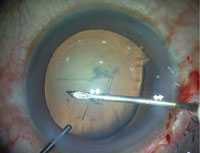
Figure 1a. Scleral flap has been created centered on the area of dialysis. Capsulorrhexis is being performed. Vitrectomy is also performed for any prolapsed vitreous.
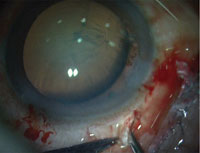
Figure 1b. Sclerotomy is made under the scleral flap with a 20-gauge needle directed toward the vitreous cavity just as in a glued IOL.
Images: Agarwal A
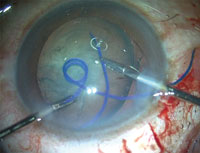
Figure 1c. The glued ECHR segment is inserted with the arms under the rhexis.

Figure 1d. The haptic of the device is externalized through the sclerotomy using the handshake technique.
Images: Agarwal A
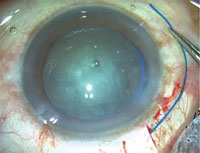
Figure 2a. The rhexis is engaged with the Malyugin-type double scrolls. On pulling the haptic, the entire capsular bag complex centers.
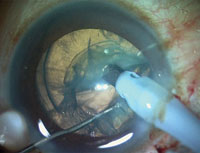
Figure 2b. The haptic is tucked into a Scharioth scleral tunnel to stabilize the bag, and phacoemulsification is performed.
Images: Agarwal A
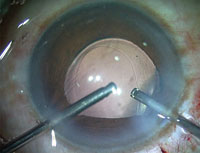
Figure 2c. The IOL is implanted in the bag and is seen well centered.

Figure 2d. The haptic can be seen tucked in a coat hanger manner into the scleral tunnel. This hooks the capsular bag onto the scleral wall. Fibrin glue is used to seal the flap hermetically as in the glued IOL technique. The conjunctiva is also closed with fibrin glue.
Images: Agarwal A
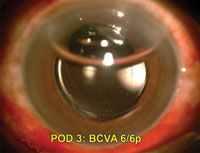
Figure 3a. Clinical photograph showing a well-centered capsular bag on day 3 following the procedure.
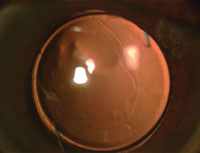
Figure 3b. Postoperative appearance of the same eye at 3 months showing a well-centered bag and BCVA of 6/6.
Images: Agarwal A
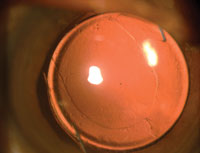
Figure 3c. A well-centered bag-IOL complex at 6 months postop. The eye is quiet and BCVA of 6/6 is maintained.

Figure 3d. At 6 months postop, the blue color of the haptic can be seen under the scleral flap and conjunctiva. The coat hanger tuck is seen. The haptic is seen to be lying inert under the flap.
Images: Agarwal A
Because the haptic is an extension of the intraocular device and has a broader gauge — 130 µm, the same gauge as an IOL haptic — it offers stable, long-term fixation, more rotational stability, and less pseudophacodonesis than trans-scleral suturing of the capsular bag.
Phacoemulsification, cortex aspiration and in-the-bag IOL implantation are then carried out as usual. At the completion of surgery, capsular bag centration is again checked and adjusted by fine-tuning the degree of haptic tuck within the scleral tunnel. This is in contrast to sutured capsular bag fixation, in which it is difficult to adjust the degree of centration once the suture is tied down to the scleral wall.
Once the capsular bag is centered, fibrin glue is used to hermetically seal the flap as well as close the conjunctiva as in the glued IOL procedure. Glue may also be used to seal clear corneal incisions.
The ECHR segment can also be used in subluxated IOLs when the capsular bag is intact. Surgery is performed following the same principles. The lamellar scleral flap is centered on the area of dialysis. The capsular bag is expanded using viscoelastic, and a 20-gauge sclerotomy is made under the scleral flap. The device is then introduced into the anterior chamber so that the arms lie within the expanded capsular fornix and the double scroll mechanism engages the rhexis rim. Pulling the exteriorized haptic centers the bag and the IOL.
Centration adjustment, explantation
It is important to place the scleral flap centered on the zone of dialysis to avoid decentration of the capsular bag-IOL complex. In the event of a malpositioned scleral flap, it easy to create a new scleral flap, interiorize the device haptic and then re-exteriorize it through a new, correctly positioned sclerotomy. Both flaps are then glued down. This is in contrast to the sutured fixation technique, in which the suture knot needs to be cut and the device explanted before the device can be transsclerally sutured all over again, making the procedure difficult, time-consuming and cumbersome.
The ECHR segment was found to provide sufficient capsular support in accidental anterior capsular tear occurring after device insertion, and it was possible to continue with careful phacoemulsification, cortex aspiration and IOL implantation. However, we do not recommend implanting the device in a pre-existing anterior capsular tear for fear of capsular tear extension during the insertion maneuvers. The glued ECHR segment offers good long-term stability and ease of surgery, as well as the ability to easily adjust capsular centration.
Intraoperative explantation of the glued ECHR segment for any reason is also relatively simple. Because the device is flexible, it can be pulled out under cover of a viscoelastic after interiorizing the device haptic.
Subluxated cataracts have been a surgical challenge, and surgeons around the world have paved the path toward overcoming hurdles associated with surgery and successful IOL implantation. We describe this new glued endocapsular hemi-ring segment for sutureless fibrin glue-assisted transscleral fixation of the capsular bag and hope to be part of the continuing effort to correct subluxation and improve the surgical result in these difficult cases.
References:
- Jacob S, Agarwal A, Agarwal A, et al. Glued endocapsular hemi-ring segment for fibrin glue-assisted sutureless transscleral fixation of the capsular bag in subluxated cataracts and intraocular lenses. J Cataract Refract Surg. 2012; 38(2):193-201.
- Vasavada AR, Praveen MR, Vasavada VA, et al. Cionni ring and in-the-bag intraocular lens implantation for subluxated lenses: A prospective case series. Am J Ophthalmol. 2012;153(6):1144-1153.
- Werner L, Zaugg B, Neuhann T, Burrow M, Tetz M. In-the-bag capsular tension ring and intraocular lens subluxation or dislocation: a series of 23 cases. Ophthalmology. 2012;119(2):266-271.
For more information:
- Edited by Thomas John, MD, a clinical associate professor at Loyola University at Chicago and in private practice in Oak Brook, Tinley Park and Oak Lawn, Ill. He can be reached at 708-429-2223; fax: 708-429-2226; email: tjcornea@gmail.com.
- Soosan Jacob, MS, FRCS, DNB, and Amar Agarwal, MS, FRCS, FRCOphth, can be reached at Dr. Agarwal’s Eye Hospital and Eye Research Centre, 19 Cathedral Road, Chennai 600 086, India; fax: 91-44-28115871; email: dr_soosanj@hotmail.com or dragarwal@vsnl.com.
- Disclosures: Drs. John, Jacob and Agarwal have no relevant financial disclosures.
